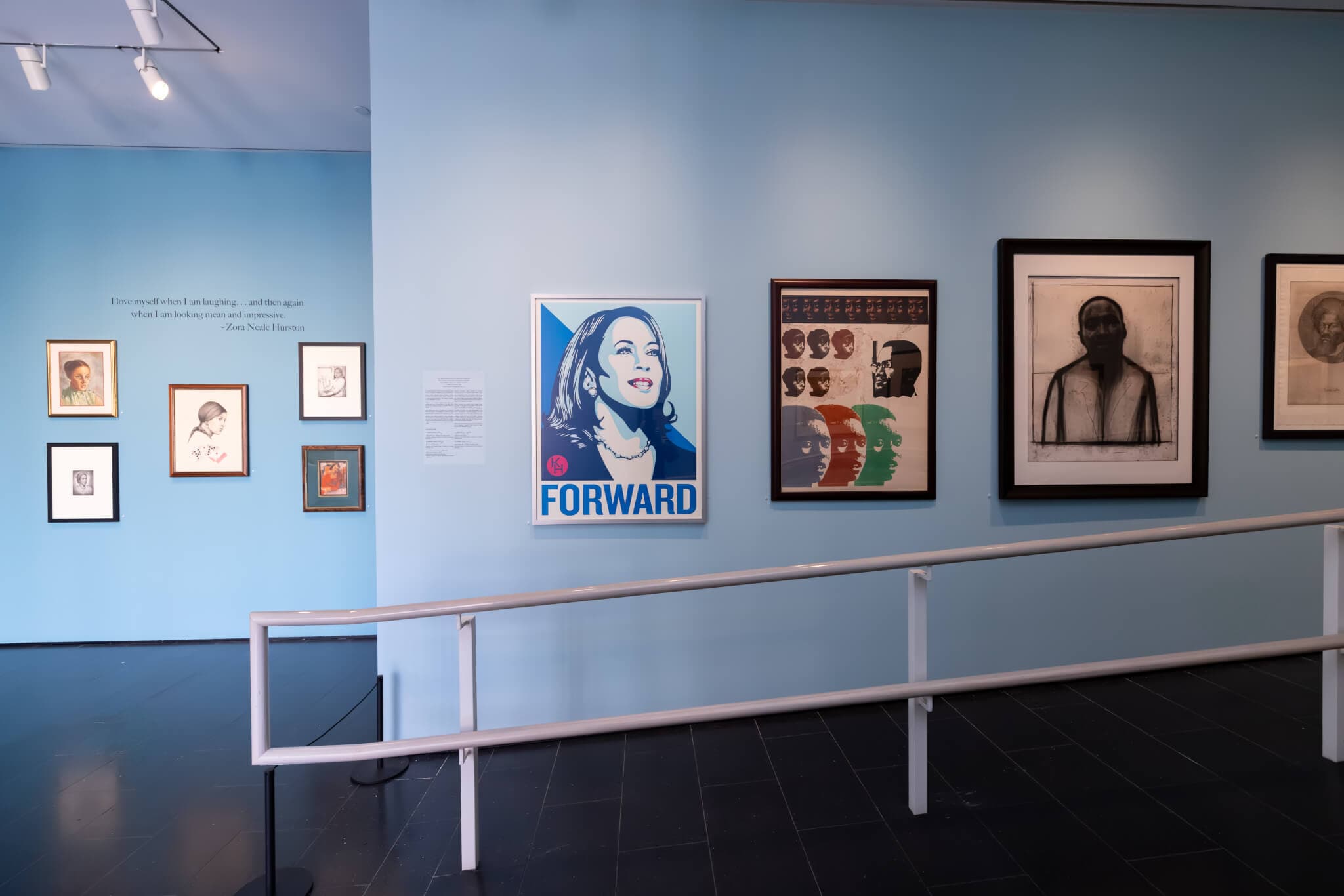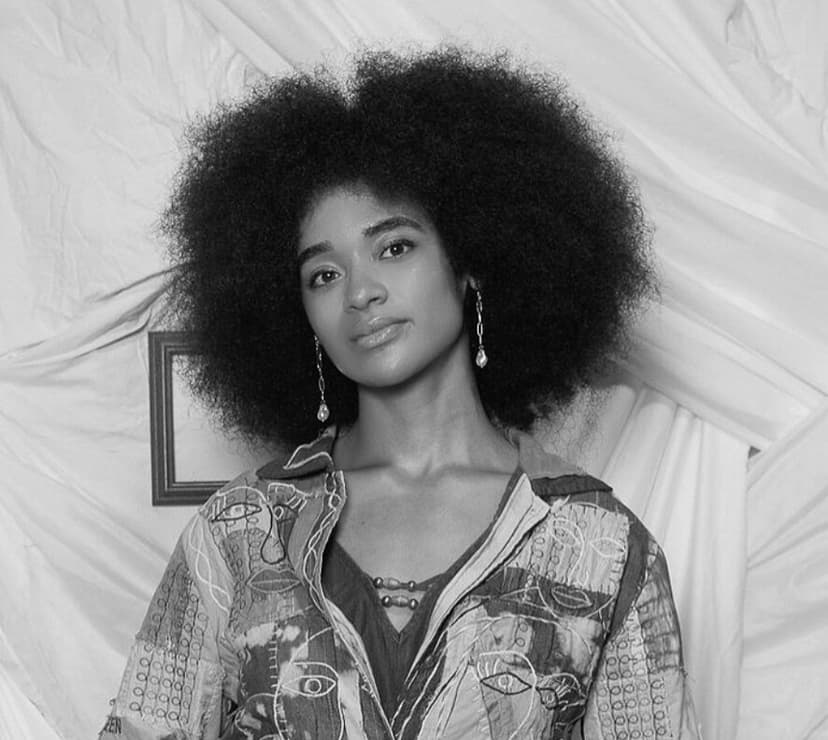The moment you step into the Alain Locke Gallery, a distinctive haint blue wraps around you, a color steeped in spiritual protection and Southern tradition. This deliberate atmospheric choice charges the space with cultural memory and contemporary resonance. The exhibition currently on view through June 6, 2026, “Renaissance, Race, and Representation in the Harmon and Harriet Kelley Collection of African American Art,” unfolds across multiple galleries: An entryway featuring works by Catlett, Douglas, and Sallee flows into walkways of political posters and landscapes, past a dedicated Bearden room, toward the WPA printmaking gallery at the heart of the show. Across from the WPA space, a room of prints and linoleum cuts is anchored by Carl Van Vechten’s 1941 Kodachrome portraits of Alain Locke himself. The journey concludes in a contemporary back gallery (1930s–1990s) and a documentary viewing room screening Amber Edwards’s Against the Odds: The Artists of the Harlem Renaissance (1994). Here, across these interconnected spaces, the visual articulation of Black life becomes central.
The unveiling of this exhibition alonside the concurrent centennial anniversary of Alain Locke’s seminal text Harlem, Mecca of the New Negro (1925) is pregnant with special significance. This exhibition is a mighty survey of Black aesthetic production and a pilgrimage to the visual epistemology that undergirds Afromodernism, inviting viewers, including artists, scholars, and the broader public alike, to reckon with the century-long effort by Black creators to command and shape a national Black aesthetic.
Locke, the “Dean of the Harlem Renaissance,” understood that the American flavor of freedom had a visual syntax. His 1925 demand to find “the elements of truest social portraiture” in the “artistic self-expression of the Negro today”1 established a mandate. This magnificent and sprawling collection, brought together by the visionary stewardship of Dr. Harmon and Mrs. Harriet Kelley, is the profound answer to that call, tracing a lineage from the high modernism of the Renaissance through the political urgency of the mid-century and into the contemporary moment. Inspired by the great scholar and artist David Driskell, and resisting the hollow accumulation of art as commodity, collecting was a deeply political and culturally restorative gesture for the Kelleys. Their practice carved out a self-determined archive of their own making, a counter-narrative to institutional neglect and market exclusion.

Carl Van Vechten, Alain Locke, 1941. Three digitized Kodachrome slides. Carl Van Vechten Papers Relating to African American Arts and Letters, Beinecke Rare Book and Manuscript Library, Yale Collection of American Literature, New Haven, Connecticut. Photo by Melissa Blackall. Courtesy of the Alain Locke Gallery.
Across these varied galleries, what becomes immediately clear is the sheer breadth and authority of the works. The collection is a veritable “who’s who” of twentieth-century Black art: Elizabeth Catlett, Jacob Lawrence, Aaron Douglas, Romare Bearden, and Lois Mailou Jones are all accounted for. Yet, the show’s enduring strength lies not in the familiar marquee names but in the deliberate curation that highlights the radical politics of medium, specifically the ubiquity of works on paper: the etchings, lithographs, block prints, and silkscreens.
The exhibition moves with deliberate purpose, establishing a flowing spatial dialogue. Past the primary hallway, visitors will find a dedicated corner showcasing material culture from the Harlem Renaissance, enhanced by the surrounding presence of works by Romare Bearden. Bearden, the preeminent collagist of the twentieth century, stands as a notable bridge figure, as his work transforms vernacular life into high modernist expression. His method, which fragmented and reassembled images from Black life, and included musicians, urban scenes, and Southern rituals, perfectly embodies the Renaissance spirit of creating a whole, self-defined image from disparate, often damaged parts. However, in these intensely visual galleries, the experience of close looking is occasionally challenged by the physical presentation. While the thematic organization is impeccable, one notes the substantial, block-like interpretive panels, necessary as they are for context, sometimes compete with the delicate presentation of the artworks. For instance, along the preliminary walkway of political campaign posters and lithographs preceding the Bearden room, a large block of wall text positioned at the start of the hallway provides information for the entire sequence of works, including Shepard Fairey’s offset lithograph Kamala Harris (2025). After walking the length of the hallway, visitors must then return to the beginning to locate the label information, forcing a disjointed viewing experience that disrupts the natural flow of looking and learning.

Installation view, “Renaissance, Race, and Representation in the Harmon and Harriet Kelley Collection of African American Art,” Alain Locke Gallery of African and African American Art at the Hutchins Center, Cambridge, MA, 2025. Photo by Melissa Blackall. Courtesy of the Alain Locke Gallery.
Presentation challenges notwithstanding, the exhibition’s strength lies in how the works themselves navigate the space between aesthetic refinement and depiction of raw political testimony. Consider Charles White’s Untitled (L14) (1970) from the Wanted series, a bold composition of yellow and black that superimposes two Black faces in circular vignettes over a densely abstracted, collage-like wreckage marked by the date “1619” and another year indicated only as “19??.” The work is a visual indictment, collapsing four centuries of history onto the collective Black countenance. It speaks to a shared memory, an identity forged in the crucible of time and trauma. Positioned on the opposite wall, another print argues for self-reclamation. Elizabeth Catlett’s Malcolm Speaks For Us (1969) juxtaposes multiple small, intense, almost expressionistic renderings of Black heads with bold, color-blocked profiles and a central figure of Malcolm X himself. It is a stunning visual genealogy of the Black face, from stereotype and caricature—a visual vocabulary these artists confronted throughout their careers as Black imagemakers working against dominant misrepresentations—to self-determined, modernist silhouette.
Moving beyond the collection’s more celebrated portraits and paintings, the decision to dedicate an entire room to printmaking is the critical pivot of the exhibition. The print, in its reproducible, democratic form, directly challenges the elitism of an art market that historically excluded Black creators. This section reminds us that the WPA-era artists, including White and Lawrence as well as Ernest Crichlow, were engaged in a project of mass cultural uplift. Rather than for the gilded parlor, they were producing art for community centers, for public walls, for the people. This commitment to a populist visual language is palpable in the stark, shadow-laden energy of Lawrence’s 1963 piece Two Rebels. Heavy black ink, simplified figures, disembodied eyes, and shadows holding objects convey the enduring psychological and political stress of the long Civil Rights struggle, proving that the Renaissance did not end in 1940; it simply deepened its resolve.

Charles White, Untitled (L14), detail, 1970. Photo by Melissa Blackall. Courtesy of the Alain Locke Gallery.
“Renaissance, Race, and Representation” resists the dutiful survey exhibition format—the chronological march through “firsts” and stylistic developments—to meditate instead on the Black body as a site of myth, resistance, and interior life. Emma Amos’s Thank you Jesus for Paul Robeson (1995) features Paul Robeson, documented not just as an actor or athlete, but as the political figure, the anti-fascist, the blacklisted activist. The work shows the Black body as an artifact of political scrutiny and heroic performance, simultaneously elevating Robeson as an individual whose radical commitments defined his life, while also rendering him as a national archetype of Black political consciousness and physical strength. The multiple views of his nude, powerful form, set against the detailed biographical text of his radical life, demand that we see his aesthetics and his activism as indivisible. Amos renders Robeson’s physical presence, often hypervisible on stage and screen, both vulnerable and monumental, forcing a confrontation with the state’s attempt to erase his radical legacy. The Black body here becomes legible on its own terms: a site where legend and biography, public performance and private conviction, physical form and political consciousness, refuse to be separated.
Alison Saar, working in the same period as Amos, pursues this same assertion of Black figural sovereignty but locates it in the realm of private imaginings rather than public valor. Saar’s Black Snake Blues (1994), a vivid, sensuous color lithograph of a reclining Black woman, draped in a brilliant yellow gown and resting on rich red bedding, with a slick, black snake coiled on the cushion beside her, embodies this evolution. While artists of the New Negro Movement were often bound by uplift ideology that emphasized respectability and documentary realism, later generations, which included Saar, inherited that foundational impulse to self-define but expanded it into realms of myth, sexuality, and psychological complexity. This figure is mythological, erotic, and deeply ambiguous. It suggests a Black Eve, a Black Medusa, or simply a woman in profound, dangerous repose. The artist deploys color and form to speak to a deeper, more intimate sense of self, a Black interiority that resists external classification. This piece, along with Margo Humphrey’s San Antonio Passage (1988), an intensely dynamic, near-surreal drawing of a woman running or leaping from an archway near the San Antonio River, underscores the full range of Black figuration. Together these works dare to embrace the expressive, the sensual, and the mystical alongside the documentary and the heroic. Humphrey’s running figure, a whirlwind of motion against a stark desert landscape, with hair flying, limbs stretching, embodies the kinetic history of migration, flight, and displacement that defines the Black American experience.

Alison Saar, Black Snake Blues, 1994. Color lithograph. Harmon and Harriet Kelley Collection of African American Art. Photo by Melissa Blackall. Courtesy of the Alain Locke Gallery.
“Renaissance, Race, and Representation” succeeds precisely because it refuses to treat the visual legacy of Black self-definition as static or complete. The Kelley Collection is a remarkable achievement, one that honors the past by ensuring its visual language remains vital, critical, and immediately present. It offers not just a view of Black art, but a necessary instruction on how to look at ourselves, then and now. The Kelleys, like Locke, understood that the preservation of this visual legacy is the ongoing, essential work of cultural freedom, work that finds its most eloquent expression right here in the newly named Alain Locke Gallery. By placing the printmakers of the WPA and the expressionists of the subsequent decades in dialogue, it posits a conversation that stretches forward, through the Depression-era regionalism, past the Black Arts Movement, and right up to the work of contemporary artists like Saar and Amos. Moreover, the exhibition’s commitment to highlighting the radical politics of medium, particularly the democratic, reproducible nature of printmaking, underscores that the tools of cultural production are as indispensable as the images themselves. In doing so, the show insists that the work of self-definition rooted in the New Negro Movement is continuous, adaptive, and ever-expanding.
—1 Alain Locke, “The New Negro: Introduction,” 1925.
“Renaissance, Race, and Representation” is on view through June 6, 2026, at the Alain Locke Gallery of African and African American Art, 102 Mount Auburn Street, Cambridge, MA.





